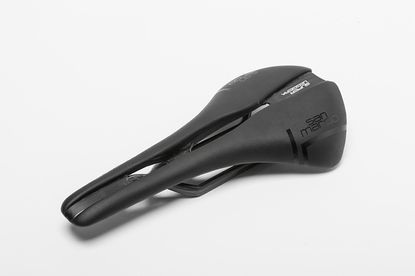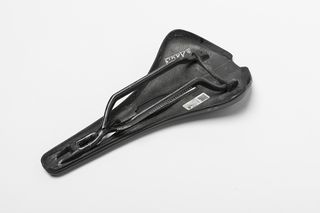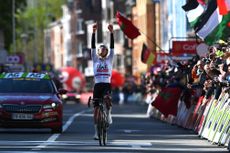Selle San Marco Mantra Superleggera Open saddle review
The Selle San Marco Mantra Superleggera Open is a super-lightweight saddle that won't leave you hurting after a long ride

At 114g for our test saddle the Selle San Marco Mantra Superleggera Open saddle will be a great weight saver for any bike. In addition, if you prefer flat, narrow saddles it remains relatively comfortable even on the longer rides.
-
+
Super lightweight
-
+
Relatively comfortable
-
-
Rail cross section can get in the way of some seat clamp designs
You can trust Cycling Weekly.
If you want a lightweight saddle then you should certainly take a good look at the Selle San Marco Mantra Superleggera Open. You'll struggle to find anything lighter with the same level of comfort.
At a very svelte 114g, it’ll certainly help keep the weight down on your steed. Each Selle San Marco Mantra Superleggera Open saddle is hand made, meaning that each will come out at a slightly different weight. Selle San Marco promises no saddle will weigh more than 117g but if you get lucky yours could be even lighter than ours at 114g.
The party piece of the Superleggera is the carbon rail, which Selle San Marco says will allow you to use all of it for fitting purposes: usually you have limits as to how far forward or back the saddle can go.
However, the joining cross section of the rails – located towards the front of the saddle – can limit saddle position (this was evident with the Pinarello Dogma F8 seat clamp), meaning it has a setback limit on certain designs.

It is a flat saddle and personally liking the Fizik Arione shape, I liked this too. It allows for a little bit of forward or backwards movement on top of the saddle for different riding positions.
Even with the relief channel (the cut-out) you’ll be able to find all kinds of riding positions, including a pretty aggressive on-the-nose style, without any obstruction or lack of comfort.
However, a small niggle for me is the size of the ‘wings’ at the rear, which can be fairly noticeable when sitting back in the saddle, especially on climbs.
It is a decent lightweight option – not totally perfect for me but with such a lightweight saddle you have to expect one or two shortcomings. The main thing is that it remains comfortable, even over long distances.

Thank you for reading 20 articles this month* Join now for unlimited access
Enjoy your first month for just £1 / $1 / €1
*Read 5 free articles per month without a subscription

Join now for unlimited access
Try first month for just £1 / $1 / €1
Get The Leadout Newsletter
The latest race content, interviews, features, reviews and expert buying guides, direct to your inbox!
Symon Lewis joined Cycling Weekly as an Editorial Assistant in 2010, he went on to become a Tech Writer in 2014 before being promoted to Tech Editor in 2015 before taking on a role managing Video and Tech in 2019. Lewis discovered cycling via Herne Hill Velodrome, where he was renowned for his prolific performances, and spent two years as a coach at the South London velodrome.
-
 ‘It’s super special’ - Tadej Pogačar on taking his sixth Monument victory at Liège-Bastogne-Liège
‘It’s super special’ - Tadej Pogačar on taking his sixth Monument victory at Liège-Bastogne-LiègeThe UAE Team Emirates rider took a dominant victory at La Doyenne with a decisive attack on La Redoute
By Joseph Lycett Published
-
 Grace Brown outsprints the favourites to win Liège-Bastogne-Liège Femmes
Grace Brown outsprints the favourites to win Liège-Bastogne-Liège FemmesThe FDJ-SUEZ rider finally takes the victory at La Doyenne after finishing runner-up in 2020 and 2022
By Joseph Lycett Published
-
 Tadej Pogačar wins Liège-Bastogne-Liège with an unstoppable attack on La Redoute
Tadej Pogačar wins Liège-Bastogne-Liège with an unstoppable attack on La RedouteThe UAE Team Emirates rider takes his sixth Monument victory at La Doyenne
By Joseph Lycett Published